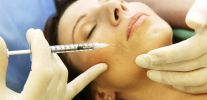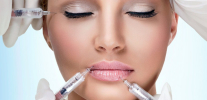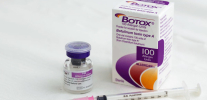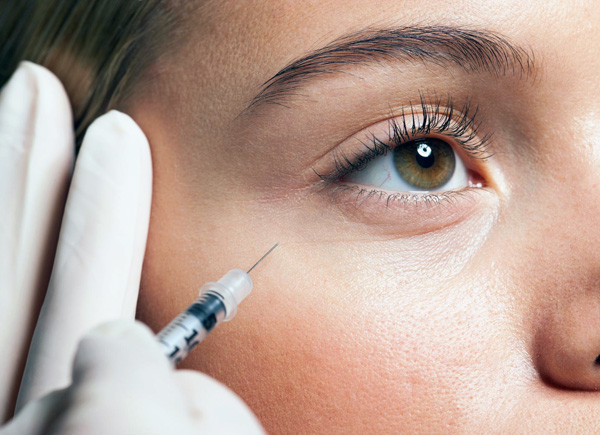
Injections of Botox and its analogues in the area near the eyes are much less common than in the interbrow or frontal muscles. This is mainly due to the less noticeable wrinkles in these places: if the glabellar or transverse folds on the forehead are very striking, then the "crow's feet" in the corners of the eyes become noticeable only in large quantities or with a significant depth.
For example, look at the photo below for comparison. Here on the left is the crease between the eyebrows before Botox injections, and on the right after them:
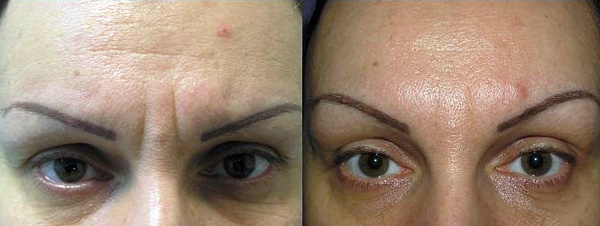
And in this photo - similarly, wrinkles in the corners of the eyes before and after botulinum therapy:
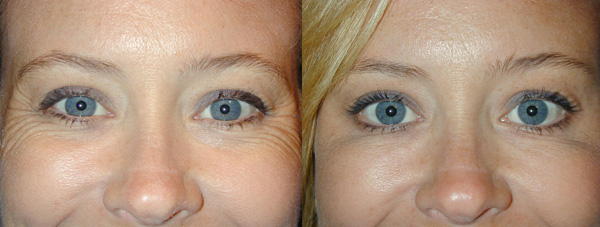
As you can see, the "crow's feet" as a whole are not so noticeable. In addition, they, like the most common wrinkles in the periorbital zone, are associated with the expression of positive emotions. They appear precisely with a smile or a laugh and therefore in the early stages are not even considered a cosmetic defect.
Later, when these wrinkles become permanent and remain even on a calm face, they are trying to get rid of them.
In addition, the constantly present wrinkles in the corners of the eyes give the face a tired, somewhat sad look, age it, because noticeable “crow's feet” develop precisely in the process of skin aging, as a rule, at the end of the third decade and the fourth ten years of life, being an objective sign age. Eliminating them, you can achieve a noticeable effect of facial rejuvenation.
At the same time, the technique of eliminating wrinkles both in the corners of the eyes and under them is very specific due to the very thin skin and the absence of fat layer here. If under the eyes or near the nose the folds are still subject to some correction by fillers, then “crow's feet” are typical dynamic wrinkles that are almost impossible to get rid of with fillers. Botox is the optimal and almost the only effective tool, with proper use, it can almost completely remove them.
Take a look at the photo below:
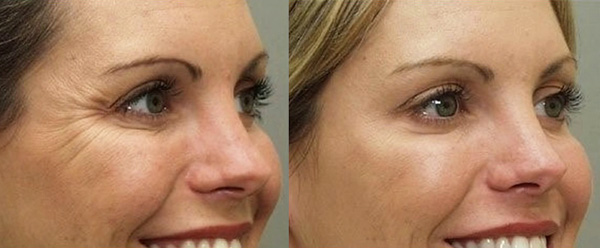
This is the result of treating wrinkles in the corners of the eyes with Dysport, an analogue of Botox. As you can see, after the injections on the skin there were no noticeable traces of “crow's feet”.
How is this result achieved and what are the nuances of Botox injections into the area around the eyes?
What types of wrinkles in the eye area can be eliminated with Botox
The most common indications for Botox injections into the periorbital region are wrinkles that appear in the outer corners of the eyes when smiling, laughing or squinting. Due to their characteristic appearance, these wrinkles are called “crow's feet”. The photo shows examples of them:
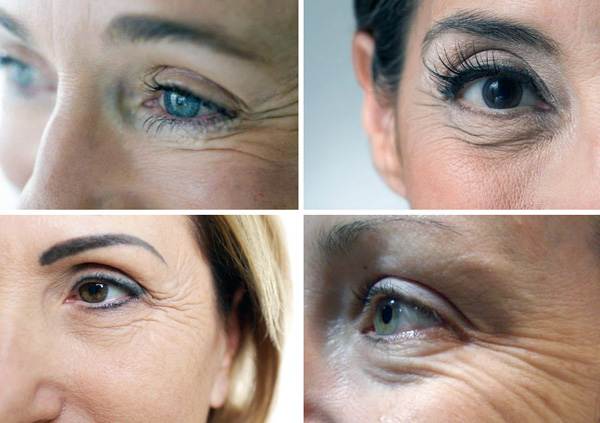
In cosmetology, it is customary to distinguish 4 types of "crow's feet":
- Fanning from the upper eyelid to the upper cheek;
- Located only on the lower eyelid and on the upper part of the cheeks (they are often allocated into a separate group of wrinkles);
- Wrinkles of the upper eyelid, diverging down to the outer corner of the eye;
- Folds located almost horizontally and only in the central zone at the outer edge of the eye.
Basically, they appear during contraction of the circular muscle of the eye, which is responsible for closing the eyelids and squeezing, but the zygomatic muscles also make a certain contribution to their development.
All of them to one degree or another can be corrected by the introduction of botulinum toxin preparations, but in some cases, doctors prefer not to touch the wrinkles on the upper eyelid, if there is a fear that along with smoothing the skin ptosis will develop in this place.
Another common problem in the periorbital region that Botox fights is the “rabbit” wrinkles that appear on the back of the nose when expressing emotions of disgust, fear, and rage.
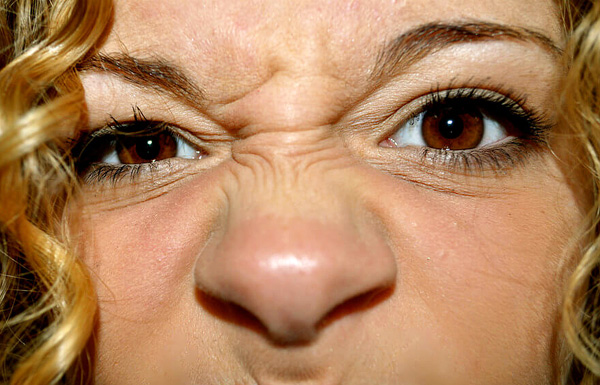
"Rabbit" wrinkles are formed on the upper and lateral parts of the nose.
A separate cosmetic defect eliminated by Botox injections is the asymmetry of the eye section, in which, in a normal state, the upper eyelid in one eye is lowered slightly lower than in the other. In this case, the drug botulinum toxin is injected into the muscle that lifts the eyelid, the lower edge of which is higher. However, this procedure requires jewelry accuracy both in choosing the injection site and in choosing the dosage of the product.
Feedback
“My experience has shown that under the eyes Botox does not help. I have a doctor - generally a super professional, solves any problems on the face (and not only). And when I showed my wrinkles under my eyes and asked them to be removed, she advised fillers and a lift. I insisted on Botox because it clearly helps on the forehead and in the corners of the eyes. The doctor did everything perfectly, the wrinkles disappeared, but the nasolabial aggravated. Apparently, some unsuccessful compensation went. After six months, everything returned to normal, made hyaluron and thread here, pulled it up a bit, but did not completely get rid. But Botox is no longer prick here.
Ala, Zelenograd
A similar problem, solved by injections of botulinum toxin preparations, is the flattened upper eyelids. Often this defect is associated with excessive tension of the circular muscle of the eye, and the correct relaxation of it with botulinum toxin allows you to raise the eyelid, increase the total section of the eyes and make the eyes more expressive.
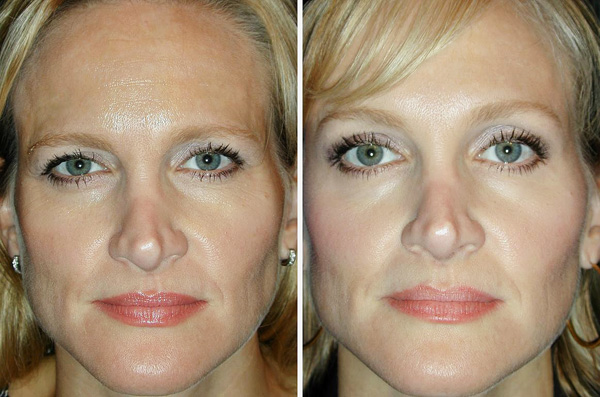
Drugs containing botulinum toxin can lift the eyelids.
Botox can also be injected under the eyes and around them for the treatment of not cosmetic, but pathological defects - strabismus, blepharospasm, hemifacial spasm. In these cases, as a rule, large amounts of the drug are used, and the target muscles may differ from those in the treatment of wrinkles.
Some defects in the periorbital region with the help of injections of botulinum toxin are not eliminated. These include a lacrimal groove, dents on the skin in the upper part of the cheeks, similar dents in the corners of the eyes, on which “crow's feet” appear on top. All of them are associated with changes in the structure of the skin, which lead to its thinning, decreased tone and aging. They are eliminated, as a rule, with the help of fillers and hardware tightening.
On a note
Small wrinkles on the lower eyelids are considered a problem requiring complex treatment. Partially they are eliminated with the help of injections of botulinum toxin, partly with filler injections. This is due to the fact that the causes that cause them are also heterogeneous - these wrinkles develop both due to the constant mobility of the skin on the lower eyelid and due to its aging.
The severity of the result and its duration
With the correct administration of botulinum toxin, the main and most noticeable wrinkles around the eyes - crow's feet, rabbit wrinkles, vertical wrinkles in the upper part of the cheeks - completely disappear a few days after the procedure, when the effect of injections is fully apparent.
The photo below shows the condition of the patient's face before injections of botulinum toxin and 3 days after them:
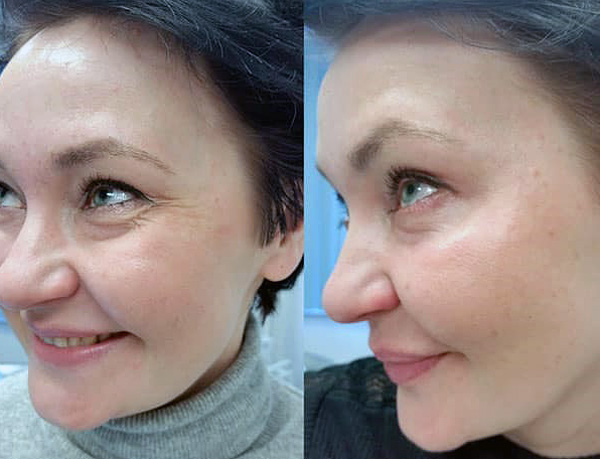
It can be seen that the "crow's feet" disappeared completely.
The situation with wrinkles in the upper part of the cheeks is similar:
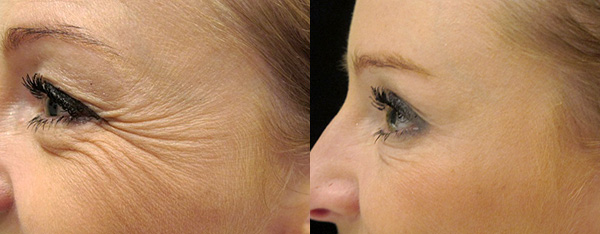
The situation with "rabbit" folds is less clear in this respect. Beauticians believe (and many patients confirm this) that their complete elimination greatly violates the natural facial expressions and leads to the effect of a “wax face” when, when a patient expresses certain emotions, it seems that a mask is put on his face.
The photo below shows an example of such an excess effect of botulinum therapy:

For this reason, correction of “rabbit” wrinkles is most often carried out partially: so that folds that remain on a calm face are eliminated, but that with strong emotions they appear, providing a full expression of feeling.Obviously, in these cases, a very accurate calculation of the dosage of the drug is required to achieve just such a partial effect.
If in the diagnosis of wrinkles it turns out that they have a complex origin, then botulinum therapy and methods for eliminating static wrinkles are combined in the treatment. This is most relevant for the treatment of crow's feet in elderly patients, as well as for the elimination of wrinkles in the lower and upper eyelids.
The results of such complex therapy are shown below:
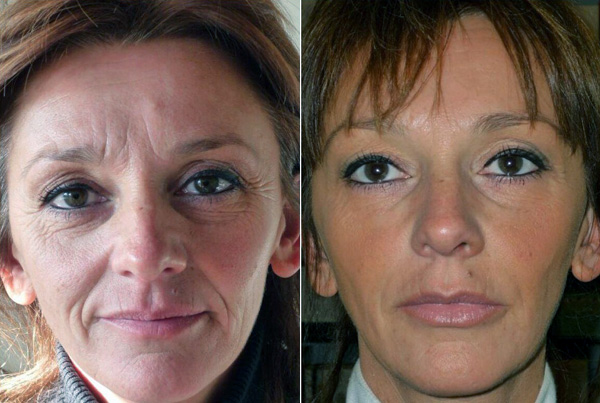
The effects obtained last for 6-12 months, depending on the sensitivity of the patient and the properties of the selected drug. The norm is the absence of wrinkles after injections for 7-9 months.
On a note
It is necessary to take into account the fact that the effect of using fillers and other cosmetic procedures often lasts longer than the effect of botulinum therapy. Therefore, a situation may arise when large dynamic wrinkles after 8-9 months begin to appear on smooth skin, devoid of a mesh of small static folds.
What is better to use: Botox or its analogues?
Traditionally, Botox, as the most well-known drug, is preferred to eliminate wrinkles in the eye area. This is not even due to the fact that the effect of its use is the most predictable, but to the fact that the patients themselves most often ask to “deliver” Botox. Nevertheless, this drug is already so famous that its name has become a kind of household name, and patients are confused by the mere thought that such an important procedure can be carried out with the introduction of less famous drugs.
At the same time, cosmetologists are actively using Xeomin, Relatox (a Russian drug), Dysport and some other drugs as an alternative to Botox. With due professionalism and experience, the doctor easily selects the dosage of each agent, which allows to achieve the desired effect. In addition, the task here is simplified by the fact that Xeomin, Botox, Relatox and most other botulinum toxin preparations are almost identical in effectiveness.
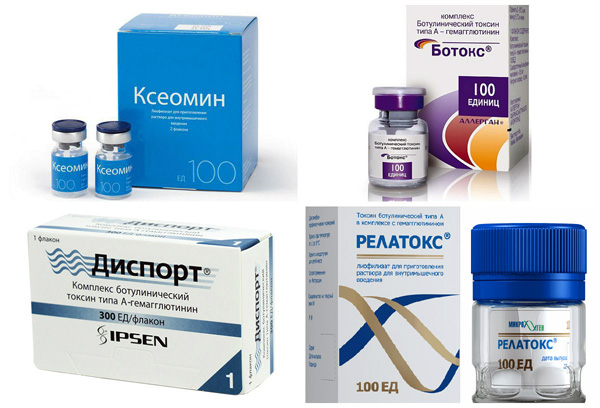
Botulinum toxin preparations
When breeding Dysport, a recalculation of doses is required, but for a specialist this task is not difficult.
The difference in prices when using different drugs is significant only when comparing Botox and its analogues with Dysport. Practice shows that Dysport injections are on average 25-30% cheaper than Botox or Xeomin injections, even though they need to be used in large quantities.
Differences in price between Botox and its full counterparts are small and are offset by the cost of a specialist. As a rule, in most clinics, the solution to a specific cosmetological task to eliminate wrinkles around the eyes is the same when using different drugs.
In general, the patient himself is not recommended to choose one or another means for injections. This is the prerogative of the doctor, who must assess the strength of the expression muscles, the age of the patient, the condition of his skin and the depth of the wrinkles, the area over which the wrinkles have already spread, the history of previous injections (if any). It is the specialist who will select the drug that is best suited for this patient in a particular case.
Points of drug administration and dosage
Botox injections around the eyes are made at several key points, the location of which depends on which wrinkles need to be removed during the procedure.

The main points of the drug for the correction of wrinkles around the eyes.
To eliminate the "crow's feet", the drug is administered in two places:
- The outer corner of the eyebrow, under which there are lateral orbital fibers of the circular muscle of the eye. At this point, 5 units of Botox or its analogues are introduced, or 15 units of Disport;
- The lower outer border of the circular muscle of the eye, located 3-5 mm below its edge. About the same amount of the drug is injected here as at the top point.
With normal muscle volume and average contractile muscle strength, these injections are usually enough to eliminate wrinkles.
If the circular muscle and its contractile force are too large, an injection can be shown at the third point located in the corner of the eye between the two above mentioned, but on the same vertical line with them. From 2.5 to 5 units of Botox or from 7.5 to 15 units of Disport are introduced into it.
In some cases, the points of administration of the drug may be larger, but the same amount of botulinum toxin is distributed between them.
So, if the wrinkles are very long and “branch” profusely, the doctor can administer the drug at 5-7 points on each side of the face, immobilizing those muscle fibers that cause wrinkles. The location of the points here is chosen by the doctor individually, depending on the pattern of wrinkles and the features of the patient's facial expressions.
To eliminate wrinkles in the upper part of the cheek, injections are performed under the eyes, closer to their outer edge. In fact, the injection points here will be in the middle of the folds of the most pronounced wrinkles. The minimum amount of the drug is injected into these places - 1-2 units, and if necessary, after a few days the procedure is repeated to enhance the effect.
Wrinkles on the lower eyelids are the most difficult to select for Botox administration points. It is difficult to distinguish between dynamic and static wrinkles on them, and therefore it is difficult to choose the injection site and dosage of the product. Most often, the doctor here is limited to 1 injection in each eyelid, 1 unit of the drug, and then punctures the drug if the effect was weaker than expected.
Finally, to eliminate “rabbit” wrinkles, 2-4 Botox units (7-10 Disport units) are introduced on both sides of the nose, and with very pronounced defects, directly into the nasal muscle on the back. In this case, injections on the sides give a more pronounced effect than an injection in the back of the nose.
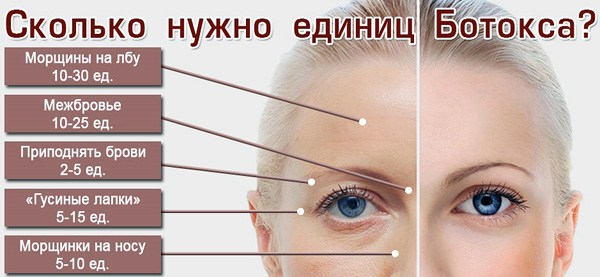
The number of Botox units for the correction of various defects.
On a note
Currently, cosmetologists believe that the leading role in the formation of “rabbit” wrinkles is played by the levator muscles of the upper lip and nose wing, therefore, after the doctor evaluates the patient’s facial expressions, other injection points for eliminating these wrinkles can be selected.
In certain difficult cases (specific facial expressions, racial features of the muscular structure, for example, in Asians), a cosmetologist may propose to break up a drug administration session into two procedures. At the first, he will introduce the minimum amount of the drug, then he will evaluate the effect and, if necessary, in the second procedure he will finish the treatment for the complete elimination of wrinkles.
How is the procedure
The procedure for the introduction of botulinum toxin is divided into the preparatory part, the actual injection and rehabilitation.
In preparation, the doctor examines the patient’s facial expressions, determines the points for administration and the amount of the drug, may ask you to make one or another facial expression, fingers feels various muscles to determine their structure and the location of the fibers under the skin. At this stage, it is important to inform the beautician about various undesirable consequences of previous procedures, if any.
Then the doctor dilutes the selected drug with a solvent to obtain the necessary amount of working medium. Perhaps he already has a restored product - today it is allowed to use the drug stored in the refrigerator for less than 30 days, since it fully retains its activity.
During the injections, the cosmetologist either stands behind the patient, having lowered the back of the chair, or injects, standing on the side - this depends on the injection sites and on the growth of the patient and the doctor. The fact is that when injecting around the eyes, the needle must be inserted at each point at different angles, in some cases at a very sharp angle to the skin. To do this, being at the same height opposite the patient's face, can be difficult.
The injections themselves are carried out using very thin needles that are inserted under the skin to a depth of 2 to 5 mm, depending on the injection site and the thickness of the fat layer here. Some doctors after each injection lightly rub the fingers with the fingers the injection site, while others do not.
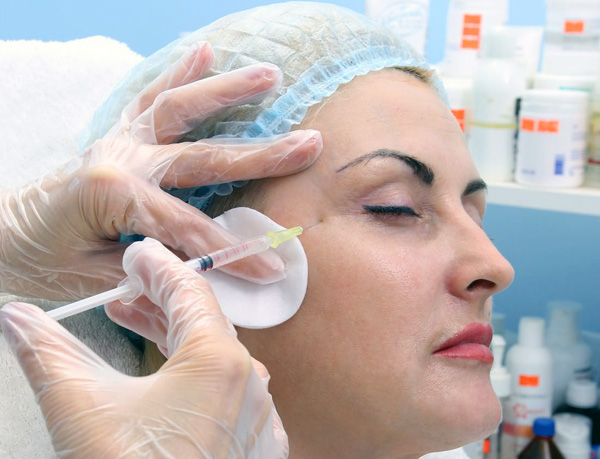
Botox injections are carried out with a special syringe with a very thin needle.
On a note
During injections, the doctor guides the needle so that even with accidental involuntary movement, minimize the risk of damage to the patient’s eyeball. For this, most specialists give injections in the direction from the nose or from top to bottom - from the patient's forehead to the chin.
At the end of the injections, the doctor monitors the patient for 15-20 minutes, so that in case of an allergic reaction, he can take action. If the patient feels well, the procedure ends.
Sometimes after botulinum therapy, the patient is prescribed additional procedures: laser resurfacing of the skin, tightening (including using microfilaments), contour plastic, filler injections. These procedures can not only enhance the effect of botulinum therapy, but also eliminate additional defects - sagging skin, sagging, age spots.
If such adjuvant therapy is required, the doctor will report it, and the patient will decide on its implementation. In any case, additional procedures are carried out no earlier than a week after botulinum therapy.
Feedback
Initially, I opened my eyes with Botox; my eyelids are very lowered. The result is perfect, my eyes straightened wide. But as soon as Botox’s action ends, the eyelids immediately fall, one stronger than the other. In general, here, in the eyebrows, I stabbed constantly. Last year, the doctor chopped all eyes around to a minimum to smooth the skin. I'll tell you, it's just magic. Earlier, I somehow did not notice that there were any drawbacks. But when Botox smoothed it all out, I saw how bad the situation was here. A lot of some fine wrinkles were gone, my eyes became even rounder. But there are also disadvantages: the nasolacrimal groove was very drawn, before it was somehow not visible behind the bags. They injected a hyaluron into it, next to it to finish off the bags. It seems that after all this epic it became good. I look like I like myself. But the bad thing is that this is all temporary: now to maintain you need to constantly stab Botox and filler, and they have different validity periods. In general, if you want to be beautiful, work hard ...
Anna, from correspondence on the forum
Is it painful to inject botulinum toxin under the eyes?
Botox injections on the side of the eyes and near the back of the nose usually do not cause pain and are often carried out even without treating the skin with an anesthetic. Only with increased sensitivity of the patient at the injection site, preliminary anesthesia with a lidocaine solution or ice cooling is required.

If the patient is too sensitive to injections, you can pre-anesthetize the Botox injection sites, for example, by cooling them with an ice mask
On a note
It was shown that injections of botulinum toxin preparations reconstituted with saline containing preservatives are less painful than injections of them, but with saline reconstituted without preservatives. For this reason, many doctors initially use preservative-containing reducing agents.
Injections in the lower eyelid are considered the most painful - the overwhelming majority of patients complain of discomfort during this procedure. Because of this, such injections are carried out using the thinnest needles, and if more than 2-4 injections are necessary, the doctor can change the needle to a new one during the procedure to prevent its blunting.
In general, even if the pain during injections appears, it is not so strong that it could not be tolerated.Most patients normally tolerate it without anesthesia, especially since there are few such painful injections forever - 1-2 in each eye.
Possible unwanted effects
The consequences of Botox injections under and around the eyes can be divided into specific, specific to the processing of these areas, and general, which are manifested with the same frequency with botulinum therapy in other parts of the face.
Specific side effects include:
- Lip prolapse associated with relaxation of the zygomatic muscles and the muscle that lifts the upper lip. Occurs rarely (less than 0.5% of patients) and usually disappears within 5-6 weeks after botulinum therapy without additional treatment;
- The appearance of specific folds under the eyes or above the zygomatic bulge due to contraction of the zygomatic muscle and elevation of the cheek. This effect develops mainly in patients with acute, strongly pronounced cheekbones and lasts long enough;
- Ptosis in cases where the drug extends to the muscle that lifts the eyelid. Often, this complication can be quickly stopped by drugs based on apraclonidine (for example, Iopidine), which stimulate the contraction of the Muller muscles and raise the eyelid;
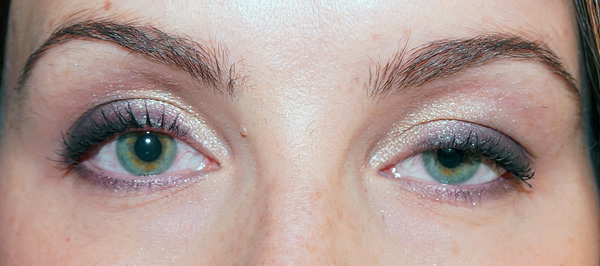
Ptosis is one of the most common side effects of botulinum therapy.
- "Bags" under the eyes when chipping the lower eyelid.
Non-specific side effects include bruising and bruising at the injection site, facial swelling, flu-like syndrome, allergic reactions, and unwanted facial expressions.
All the consequences mentioned are not hazardous to health (with the exception of allergies) and usually go away without additional therapy. However, in many cases it is useful to inform your doctor about them. He may be able to take measures to eliminate or reduce the severity of these side effects.
In addition, in some cases, the cause of the undesirable consequences of botulinum therapy becomes a violation by the patient himself of the conditions of the rehabilitation period after injections.
Rules of conduct after the procedure
The rules of botulinum therapy indicate several restrictions that patients must follow in order to avoid unwanted side effects. In particular, the procedure should not:
- Lie down for 3-4 hours;
- Take alcohol during the day;
- Go in for sports, run, bend over for 1-2 days;
- Do facial massage, rub it with your hands - for several hours;
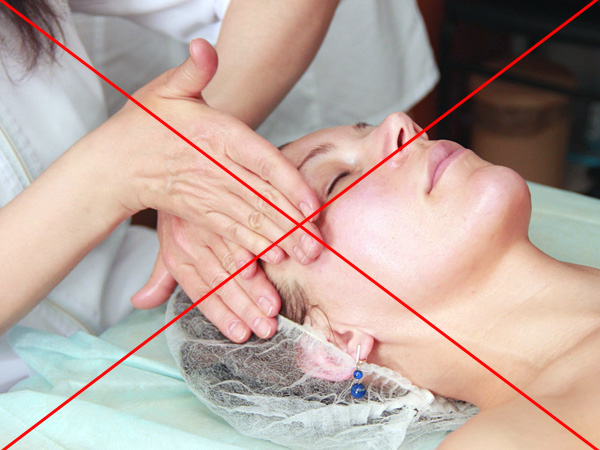
After botulinum therapy, it is forbidden to massage the face.
- Take a hot bath, steam in a bath for 1-2 days;
- To be in the sun for a long time;
- Visit the dentist.
If these requirements are violated, side effects may develop due to the fact that the drug spreads in the muscles over a larger area than the doctor calculated. At the same time, those muscles that should not have been exposed to the drug are relaxed, which leads to certain violations of the facial expressions or appearance of the patient.
If side effects do occur (it doesn’t matter if the patient is at fault or not), you should first contact the doctor who performed the procedure. It is he who will be able to take the necessary measures and advise the most effective ways to eliminate such consequences.
Available on the prevention and treatment of crow's feet, including using botulinum toxin
An interesting video about the effects of botulinum toxin on the muscles responsible for the formation of wrinkles around the eyes

